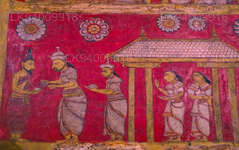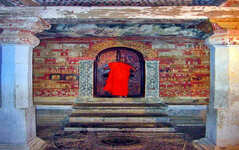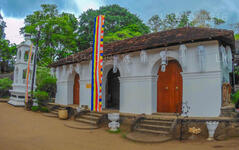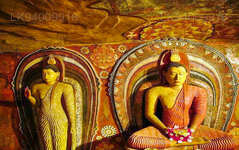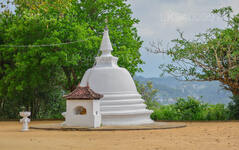
Miasto Kandy
Kandy, malownicze miasto w środkowej Sri Lance, słynie z bogatego dziedzictwa kulturowego, tętniących życiem festiwali i malowniczych widoków. Położone pośród bujnych wzgórz, jest domem Świątyni Zęba, wpisanej na Listę Światowego Dziedzictwa UNESCO, i oferuje urzekające połączenie historii i naturalnego piękna.
Degaldoruwa Raja Maha Vihara
Amongst the rocky slopes and green valleys of rural Kandy lies a hidden treasure; the Degaldoruwa Raja Maha Vihara. This temple awes those who view it with its incredible Kandyan era frescoes. Construction of the temple began in the late 1770s under the reign of King Kirti Sri Rajasinha and was completed under the reign of his brother Rajadhi Rajasinha years later.
Legend
According to folklore a farmer was exploring the area and found a crevice between two rocks. On venturing into space he found a cave with a pile of golden sickles. The farmer was delighted with his discovery but feared retribution from some strange power. So he simply took only one sickle every morning and, after using it in his fields, returned it in the evening. His fields yielded an extremely healthy harvest and the farmer attributed it to the golden sickle. But then he became greedy. After all, he had been taking the sickles every day and there had been no ill effects, and there was a whole pile of them. So on the very last day of the harvest, he took two sickles instead of one and did not return one of them.
But unknown to the farmer, there had indeed been a guardian for the treasure. The guardian noticed the farmer taking the sickles, but kept quiet as he always returned them. On the day that the farmer took one sickle for himself, the guardian saw it at once and confronted him in his home. The terrified farmer immediately rushed to the crevice and returned the golden sickle that he had stolen. The guardian, who had been disappointed, then sealed the crevice by fusing the two rocks together. However, the villagers got to know this story and informed the king, Kirti Sri Rajasinha; who then ordered that the cave be found and a temple erected in it.
The Structure
- The temple is hollowed out of a 40 foot rock outcrop extending a natural cave. It consists of an elegant rock shelter with two roofed antechambers in front; a drummers’ hall and an image house; and the main shrine room cut into the rock itself. The two antechambers are constructed outside the rock outcrop and have wooden roofs.
- The architecture is unusual for the period as the drummers’ hall is not usually attached to the main temple.
- The image house is located through a set of old wooden doors, situated under a carved wooden Dragon Arch. It preserves a moonstone and a sequence of elaborate and colorful paintings showing scenes from four Jātaka tales, which tell the stories of the previous lives of Buddha.
- The door of the shrine room is banded with metal and once had jewels embedded within it. The inner walls of the shrine are completely covered in paintings; including the door.
- In addition to this main structure, there is a bo tree and a stupa on a plateau on the summit of the rocky outcrop above the temple. They can be reached by stairs carved into the temple.
The Frescoes
The paintings of Degaldoruwa, which are supposed to be some of the best of the Kandyan era, are believed to be the work of four ‘Sittara’ artists. The finest of these paintings grace the ceiling of the temple; ‘Mara Yudde’, an artistic depiction of Buddha’s internal spiritual battle against Māra, the demon of death, rebirth, and desire.
The murals are unique in that all the elements; the people, the trees and the animals; are a uniform size and only the front views of ]people are shown. The trees have a stylized form, with their branches and leave spreading out to either side. The individual elements, such as the adornments on the elephants and the uniforms of the attendants, are portrayed in great detail. All of the colors used by the artists in the murals were created from the barks
O dystrykcie Kandy
Dystrykt Kandy znajduje się w centralnej prowincji Sri Lanki. Kandy, jedno z siedmiu miejsc światowego dziedzictwa na Sri Lance, było kiedyś domem królów Kandy w XVI wieku i źródłem całej muzyki, sztuki, rzemiosła i kultury w kraju. Około 129 km od Kolombo, Kandy jest położone wśród pagórkowatego terenu, a wszystkie oczy zwrócone są ku centrum miasta, gdzie jezioro Kandy stanowi urokliwy element. Kandy zachowuje wielkie znaczenie religijne dla Sri Lanki, ponieważ to w tym uroczym mieście znajduje się Dalada Maligawa lub „Świątynia Zęba”, w której święta relikwia zęba Buddy leży dobrze strzeżona. Królewski Ogród Botaniczny Peradeniya znajduje się około 5 km na zachód od centrum miasta Peradeniya i odwiedza go 1,2 miliona ludzi rocznie. Jest to największy ogród botaniczny na wyspie. Udawatta Kele (Las Udawatta) to chronione sanktuarium położone w sercu miasta, na północ od Świątyni Zęba. Kandy to miasto, w którym większość stanowią Syngalezi; zamieszkują je liczne społeczności należące do innych grup etnicznych, takich jak Maurowie i Tamilowie. Kandy ustępuje jedynie Kolombo centrum gospodarki Sri Lanki. Wiele dużych przedsiębiorstw ma w Kandy rozbudowane filie, a wiele gałęzi przemysłu, takich jak tekstylia, meble, technologie informatyczne i jubilerstwo, znajduje się tutaj. W mieście znajduje się wiele ośrodków badawczych w rolnictwie, a także źródło muzyki, sztuki, rzemiosła i kultury kraju. Kandy, położone około 129 km od Kolombo, położone jest na pagórkowatym terenie, a wszystkie oczy zwrócone są w stronę centrum miasta, gdzie jezioro Kandy stanowi urokliwy punkt orientacyjny. Kandy zachowuje ogromne znaczenie religijne dla Sri Lanki, ponieważ to właśnie w tym urokliwym mieście znajduje się Dalada Maligawa, czyli Świątynia Zęba, w której strzeżona jest święta relikwia zęba Buddy.
O prowincji centralnej
Prowincja Centralna Sri Lanki składa się głównie z terenów górzystych. Prowincja ma powierzchnię 5674 km² i liczy 2 421 148 mieszkańców. Do większych miast należą Kandy, Gampola (24 730), Nuwara Eliya i Bandarawela. Ludność jest mieszanką Syngalezów, Tamilów i Maurów. Zarówno stolica gór Kandy, jak i miasto Nuwara Eliya znajdują się w Prowincji Centralnej, podobnie jak Sri Pada. Prowincja produkuje dużą część słynnej herbaty cejlońskiej, uprawianej przez Brytyjczyków w latach 60. XIX wieku po tym, jak wyniszczająca choroba zniszczyła wszystkie plantacje kawy w prowincji. Prowincja Centralna przyciąga wielu turystów, a jej górskie miejscowości, takie jak Kandy, Gampola, Hatton i Nuwara Eliya, to popularne górskie kurorty. Świątynia Zęba, zwana Dalada Maligawa, jest głównym miejscem świętym w prowincji Centrel. Klimat jest chłodny, a wiele obszarów położonych na wysokości około 1500 metrów n.p.m. charakteryzuje się chłodnymi nocami. Zachodnie stoki są bardzo wilgotne, w niektórych miejscach spada tam prawie 7000 mm deszczu rocznie. Wschodnie stoki należą do strefy średniosuchej, ponieważ deszcz pada tam wyłącznie z monsunu północno-wschodniego. Temperatury wahają się od 24°C w Kandy do zaledwie 16°C w Nuwara Eliya, położonej 1889 m n.p.m. Najwyższe góry Sri Lanki znajdują się w Prowincji Centralnej. Teren jest w większości górzysty, z głębokimi dolinami. Dwa główne regiony górskie to masyw centralny i pasmo Knuckles na wschód od Kandy.


